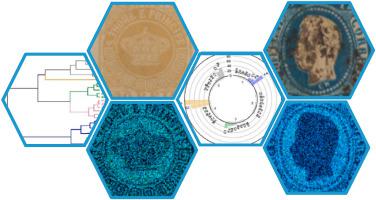Dyes and Pigments ( IF 4.1 ) Pub Date : 2022-06-23 , DOI: 10.1016/j.dyepig.2022.110519 Simone C.R. Ferreira , Martina Franchi , Alberto A.C.C. Pais , J. Sérgio Seixas de Melo

|
The analysis of 28 specimens of some of the first Portuguese postage stamps, dated from 1853 to 1894, was undertaken with non-destructive techniques: X-Ray fluorescence (XRF), Attenuated Total Reflection Fourier Transform Infrared (ATR-FTIR) and Ultraviolet–Visible Reflectance Spectroscopy (UV–Vis). Ink, paper and cancellation of the postage stamps were analysed, and the pigments, binders and fillers identified. Prussian blue was found present in all blue and also in green and brown specimens. Chrome and zinc yellow, lead sulphate and mars red were also found in other of the investigated postage stamps. Binders consist mostly of protein glue. Fillers such as calcite and kaolinite were found dominant. The presence of the latter served as an indicator for distinguishing between genuine and forged samples. UV–Vis spectra also proved useful for the same purpose. All the above information was processed and organized using chemometric techniques. These include mainly Hierarchical Cluster Analysis (HCA), for clustering stamps of similar composition, and Principal Component Analysis (PCA) for mapping the samples and identifying the more relevant variables. The latter are, in the paper, content of calcium, potassium, sulphur and silicon and, in the dye pigment area, of iron, zinc and lead content. The study introduces an approach in which, by combination of non-destructive multi analytical techniques with chemometric analysis, extensive information on different aspects of the composition of the studied postage stamps is provided, including that of paper and dyes.
中文翻译:

第一张葡萄牙邮票(1853-1894 年)背后的化学反应。颜料、填料和粘合剂的无损分析和化学计量分析
使用无损技术对 1853 年至 1894 年间首批葡萄牙邮票的 28 个样本进行了分析:X 射线荧光 (XRF)、衰减全反射傅里叶变换红外 (ATR-FTIR) 和紫外线——可见反射光谱(UV-Vis)。对墨水、纸张和邮票的取消进行了分析,并确定了颜料、粘合剂和填料。普鲁士蓝被发现存在于所有蓝色以及绿色和棕色标本中。在其他被调查的邮票中也发现了铬和锌黄、硫酸铅和火星红。粘合剂主要由蛋白质胶组成。方解石和高岭石等填料被发现占主导地位。后者的存在可作为区分真品和伪造样品的指标。紫外-可见光谱也被证明可用于相同目的。所有上述信息均使用化学计量技术进行处理和组织。这些主要包括层次聚类分析 (HCA),用于对相似成分的邮票进行聚类,以及用于映射样本和识别更相关变量的主成分分析 (PCA)。后者是纸张中的钙、钾、硫和硅的含量,而染料颜料领域中的铁、锌和铅的含量。该研究引入了一种方法,通过将无损多重分析技术与化学计量分析相结合,提供了有关所研究邮票组成的不同方面的广泛信息,












































 京公网安备 11010802027423号
京公网安备 11010802027423号